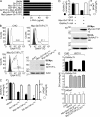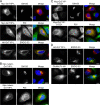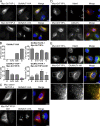A testis-specific regulator of complex and hybrid N-glycan synthesis
- PMID: 20805325
- PMCID: PMC2935569
- DOI: 10.1083/jcb.201004102
A testis-specific regulator of complex and hybrid N-glycan synthesis
Abstract
Database analyses identified 4933434I20Rik as a glycosyltransferase-like gene expressed mainly in testicular germ cells and regulated during spermatogenesis. Expression of a membrane-bound form of the protein resulted in a marked and specific reduction in N-acetylglucosaminyltransferase I (GlcNAcT-I) activity and complex and hybrid N-glycan synthesis. Thus, the novel activity was termed GlcNAcT-I inhibitory protein (GnT1IP). Membrane-bound GnT1IP localizes to the ER, the ER-Golgi intermediate compartment (ERGIC), and the cis-Golgi. Coexpression of membrane-anchored GnT1IP with GlcNAcT-I causes association of the two proteins, inactivation of GlcNAcT-I, and mislocalization of GlcNAcT-I from the medial-Golgi to earlier compartments. Therefore, GnT1IP is a regulator of GlcNAcT-I and complex and hybrid N-glycan production. Importantly, the formation of high mannose N-glycans resulting from inhibition of GlcNAcT-I by GnT1IP markedly increases the adhesion of CHO cells to TM4 Sertoli cells. Testicular germ cells might use GnT1IP to induce the expression of high mannose N-glycans on glycoproteins, thereby facilitating Sertoli-germ cell attachment at a particular stage of spermatogenesis.
Figures









Similar articles
-
GnT1IP-L specifically inhibits MGAT1 in the Golgi via its luminal domain.Elife. 2015 Sep 15;4:e08916. doi: 10.7554/eLife.08916. Elife. 2015. PMID: 26371870 Free PMC article.
-
Reduction in Golgi apparatus dimension in the absence of a residential protein, N-acetylglucosaminyltransferase V.Histochem Cell Biol. 2014 Feb;141(2):153-64. doi: 10.1007/s00418-013-1146-1. Histochem Cell Biol. 2014. PMID: 24078077 Free PMC article.
-
MGAT1 and Complex N-Glycans Regulate ERK Signaling During Spermatogenesis.Sci Rep. 2018 Jan 31;8(1):2022. doi: 10.1038/s41598-018-20465-3. Sci Rep. 2018. PMID: 29386567 Free PMC article.
-
Mice with a homozygous deletion of the Mgat2 gene encoding UDP-N-acetylglucosamine:alpha-6-D-mannoside beta1,2-N-acetylglucosaminyltransferase II: a model for congenital disorder of glycosylation type IIa.Biochim Biophys Acta. 2002 Dec 19;1573(3):301-11. doi: 10.1016/s0304-4165(02)00397-5. Biochim Biophys Acta. 2002. PMID: 12417412 Review.
-
In vivo role of alpha-mannosidase IIx: ineffective spermatogenesis resulting from targeted disruption of the Man2a2 in the mouse.Biochim Biophys Acta. 2002 Dec 19;1573(3):382-7. doi: 10.1016/s0304-4165(02)00407-5. Biochim Biophys Acta. 2002. PMID: 12417422 Review.
Cited by
-
Sugar-coated sperm: Unraveling the functions of the mammalian sperm glycocalyx.Mol Reprod Dev. 2015 Sep;82(9):635-50. doi: 10.1002/mrd.22500. Epub 2015 Jun 9. Mol Reprod Dev. 2015. PMID: 26061344 Free PMC article. Review.
-
Discovery of a lectin domain that regulates enzyme activity in mouse N-acetylglucosaminyltransferase-IVa (MGAT4A).Commun Biol. 2022 Jul 19;5(1):695. doi: 10.1038/s42003-022-03661-w. Commun Biol. 2022. PMID: 35854001 Free PMC article.
-
Golgi UDP-GlcNAc:polypeptide O-α-N-Acetyl-d-glucosaminyltransferase 2 (TcOGNT2) regulates trypomastigote production and function in Trypanosoma cruzi.Eukaryot Cell. 2014 Oct;13(10):1312-27. doi: 10.1128/EC.00165-14. Epub 2014 Aug 1. Eukaryot Cell. 2014. PMID: 25084865 Free PMC article.
-
Identification of ectonucleotide pyrophosphatase/phosphodiesterase 3 (ENPP3) as a regulator of N-acetylglucosaminyltransferase GnT-IX (GnT-Vb).J Biol Chem. 2013 Sep 27;288(39):27912-26. doi: 10.1074/jbc.M113.474304. Epub 2013 Aug 19. J Biol Chem. 2013. PMID: 23960081 Free PMC article.
-
Golgi glycosylation.Cold Spring Harb Perspect Biol. 2011 Apr 1;3(4):a005199. doi: 10.1101/cshperspect.a005199. Cold Spring Harb Perspect Biol. 2011. PMID: 21441588 Free PMC article. Review.
References
-
- Akama T.O., Nakagawa H., Wong N.K., Sutton-Smith M., Dell A., Morris H.R., Nakayama J., Nishimura S., Pai A., Moremen K.W., et al. . 2006. Essential and mutually compensatory roles of alpha-mannosidase II and alpha-mannosidase IIx in N-glycan processing in vivo in mice. Proc. Natl. Acad. Sci. USA. 103:8983–8988. 10.1073/pnas.0603248103 - DOI - PMC - PubMed
Publication types
MeSH terms
Substances
Grants and funding
LinkOut - more resources
Full Text Sources
Molecular Biology Databases

